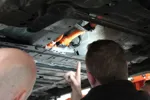The Government believes the introduction of autonomous and connected cars should not be left entirely to manufacturers – ministers must have a role.
As such, the Department for Transport (DfT) is working on a code of practice and regulatory framework for autonomous vehicles in the UK.
Transport minister John Hayes told the House of Lords Science and Technology Committee: “We have to try to establish a regulatory framework to allow us to take advantage of the opportunities they have to offer, while not assuming that those who develop the technology will be motivated in the first instances by virtue.”
Hayes said the success of autonomous vehicles would require the Government to think laterally.
Their introduction was “not a straightforward matter” and would have a knock-on effect across employment, urban planning, the concept of vehicle ownership, accessibility and safety.
AM's sister title Fleet News reports today that the DfT code of practice will set out recommendations for how automated vehicles will be tested in the UK. It has already injected £19 million into automated projects in Milton Keynes, Coventry, Bristol and Greenwich.
The Government also has a £100 million 'intelligent mobility fund' to aid similar projects.
The autumn statement recently earmarked £23 billion to be spent on transport innovation and infrastructure over the next five years, including £2bn per year by 2020 for research and development funding.
Hayes said the Government is keen to support real-world vehicle tests to look at on-the-road experience and how automated technology will fit into an existing driving landscape.
The DfT has also started a three-year project around behavioural change and public engagement which was commissioned in February this year. The first report on this will be available in the new year.
The committee meeting was also attended by leading academics in human behaviour and autonomous vehicles. Natasha Merat, professor in human factors of Transport Systems, Institute for Transport Studies (ITS), University of Leeds, said experts in her field don’t expect fully autonomous vehicles to be in use in the UK until at least 2075.
There are five levels of autonomy the industry refers to (see panel). Level 2 technology is already available in vehicles in the UK and Merat said there is a desire for manufacturers to move to level 3, but some OEMs have told her they want to skip straight to level 4.
Merat said: “I must stress that it is very much about prototypes and testing on a small scale. We are at least five years away from being able to sit in these cars as a car buyer.
“Some of my colleagues are talking about 2075 before we will realistically have access to level 5 vehicles on the road.”
Merat said the sensor and camera technology is “not there”.
She continued: “Manufacturers are researching how long will it take for the driver to take back control in an emergency. It’s a massive challenge.”
Andy Graham, White Willow director and ITS UK consultant, said due to the majority of accidents involving human error it was likely automated vehicles will have a positive effect in the future. However, he said there is a lack of research on how vehicles will hand back control to drivers in the event of an emergency and how often that situation would occur.
Sarah Sharples, professor of human factors, faculty of engineering, Nottingham University, said one of the most important things to understand is how increasing levels of autonomy in the driving task will affect being able to respond to an emergency situation and maintaining vigilance.
“Work is being done on how we develop display to help drivers maintain situational awareness,” she said. Sharples also urged caution around the unintended consequences of introducing automation into the driving task, and added: “If we are introducing automation do we lose the capability to maintain driving skills?”
She suggested passing a driving test would still be mandatory in the future and that it would have to include elements around automation.
Five levels of vehicle automation
Level 1 Driver assistance: Equipment like electronic stability control or pre-charged brakes. The driver is in complete and sole control of the primary vehicle controls – brake, steering, throttle, and motive power – at all times.
Level 2 Partial automation: This level involves automation of at least two primary control functions designed to work in unison to relieve the driver of control of those functions. Examples include adaptive cruise control in combination with automatic lane keeping.
Level 3 Conditional automation: Automated system can undertake all aspects of the driving task in specific-use cases but the human driver will intervene outside those. Hands off the wheel temporarily but eyes on the road at all times.
Level 4 High automation: The vehicle is designed to perform all safety-critical driving functions and monitor roadway conditions for an entire trip. Drivers will still provide a destination, but are only responsible outside of specific-use cases.Eyes and hands off during this time.
Level 5 Full Automation: This indicates the automated driving system can handle and interpret any aspect of driving under all roadway and environmental conditions to the same level as a human. Eyes and hands off at all times.
















Login to comment
Comments
No comments have been made yet.